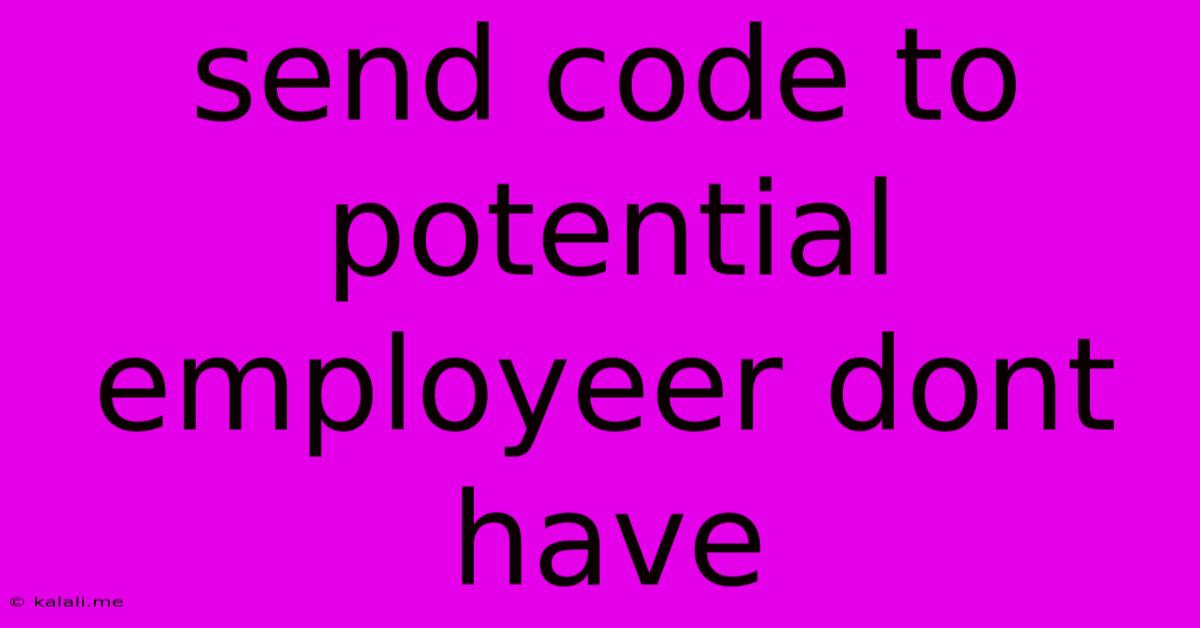Send Code To Potential Employeer Dont Have
Kalali
May 27, 2025 · 3 min read

Table of Contents
Don't Have a Code Sample to Send to Potential Employers? Here's What to Do
Meta Description: Worried about lacking a code sample to send to potential employers? This guide offers effective strategies to showcase your skills and land that interview even without a readily available portfolio. Learn how to highlight your experience, create a compelling narrative, and leverage alternative methods to prove your coding prowess.
Finding the perfect job can be challenging, especially in the competitive tech industry. Many job applications require candidates to submit code samples, showcasing their technical skills and proficiency in specific programming languages. But what if you don't have a readily available project to share? Don't panic! This article outlines effective strategies to navigate this hurdle and still impress potential employers.
Understanding the Employer's Perspective
Before diving into solutions, it's crucial to understand why employers request code samples. They want to assess your:
- Technical skills: Can you write clean, efficient, and functional code?
- Problem-solving abilities: How do you approach and tackle programming challenges?
- Coding style: Is your code readable, maintainable, and adheres to best practices?
- Experience with specific technologies: Do you possess the necessary expertise for the role?
Strategies to Showcase Your Skills Without a Pre-built Portfolio
Even without a polished portfolio, you can still demonstrate your abilities through these methods:
1. Highlight Relevant Projects from Past Roles (Even Non-Coding Projects):
- Focus on transferable skills: Even if your previous projects weren't directly coding-related, highlight aspects that demonstrate problem-solving, analytical thinking, and teamwork. For example, discuss how you improved efficiency in a process or overcame a technical challenge using creative solutions.
- Quantify your achievements: Use metrics to show the impact of your contributions. For example, “Reduced processing time by 15% through process optimization.”
- Use bullet points in your resume and cover letter to easily highlight these accomplishments.
2. Create a Small, Focused Project:
- Choose a relevant problem: Select a mini-project directly related to the job description. This demonstrates initiative and shows you're genuinely interested.
- Keep it concise: Focus on a single, well-defined feature instead of building a massive application. A well-executed small project is far more impressive than a half-finished large one.
- Document your process: Include comments in your code and create a README file explaining the project's purpose, your approach, and any challenges you faced.
3. Leverage Your GitHub Profile (Even if it's not brimming with projects):
- Showcase contributions: Even small contributions to open-source projects demonstrate your collaboration skills and willingness to learn.
- Highlight personal projects: Even small, incomplete projects are better than nothing. Clearly state their purpose and your progress.
- Keep it up-to-date: Regularly update your profile to show ongoing learning and engagement.
4. Prepare for Behavioral Questions:
- Practice explaining your problem-solving process: Be ready to discuss how you approach challenges, even if you don't have a specific code sample to show.
- Focus on your thought process: Employers are often more interested in your approach than the final product. Explain how you would tackle a particular coding problem, step-by-step.
5. Prepare a Strong Cover Letter:
- Sell your skills: Use your cover letter to address the skills mentioned in the job description.
- Highlight your experience: Showcase your achievements and quantify your impact.
- Show enthusiasm: Express your genuine interest in the company and the role.
Addressing the Lack of a Code Sample Directly
Don't shy away from acknowledging the absence of a readily available code sample. In your cover letter or during the interview, briefly and confidently explain the reasons, focusing on the positive aspects:
- "While my portfolio is currently under development, I'm eager to showcase my skills through a practical coding challenge during the interview process."
- "My previous role focused primarily on [non-coding tasks], but I'm highly proficient in [languages/technologies] and eager to demonstrate this through a practical exercise."
By strategically addressing this issue and focusing on your other strengths, you can significantly improve your chances of landing that coveted interview. Remember, your skills and experience are valuable—find creative ways to demonstrate them effectively!
Latest Posts
Latest Posts
-
Where Was Jesus When Lazarus Died
May 27, 2025
-
Was Peter In The Bible Married
May 27, 2025
-
Is Momentum Conserved If A Spring Is In The Collision
May 27, 2025
-
How To Shingle A Lean To Shed Roof
May 27, 2025
-
Wire Size For 30 Amp 240 Volt Circuit
May 27, 2025
Related Post
Thank you for visiting our website which covers about Send Code To Potential Employeer Dont Have . We hope the information provided has been useful to you. Feel free to contact us if you have any questions or need further assistance. See you next time and don't miss to bookmark.